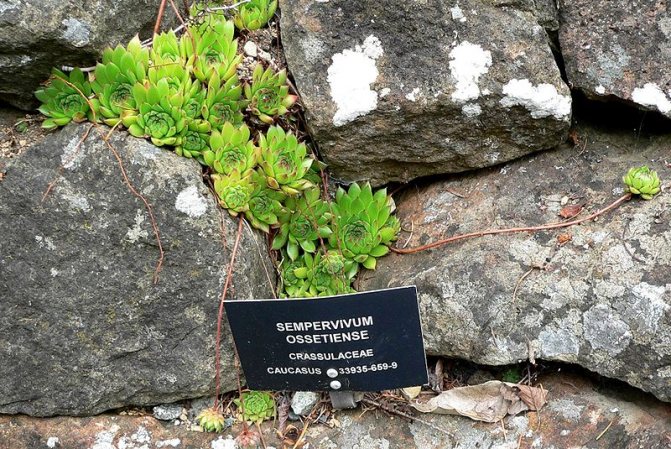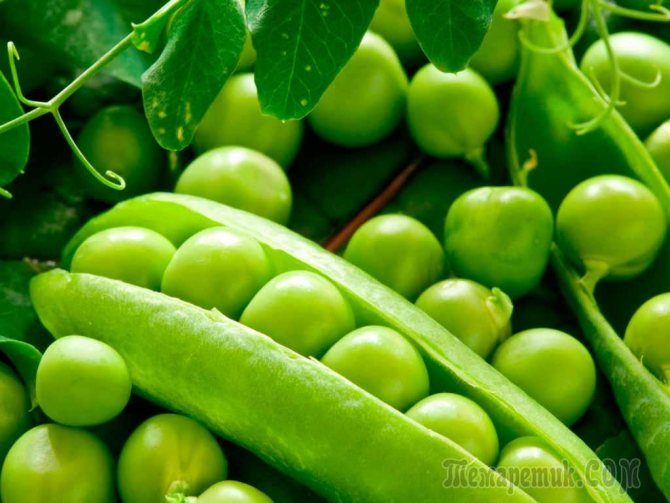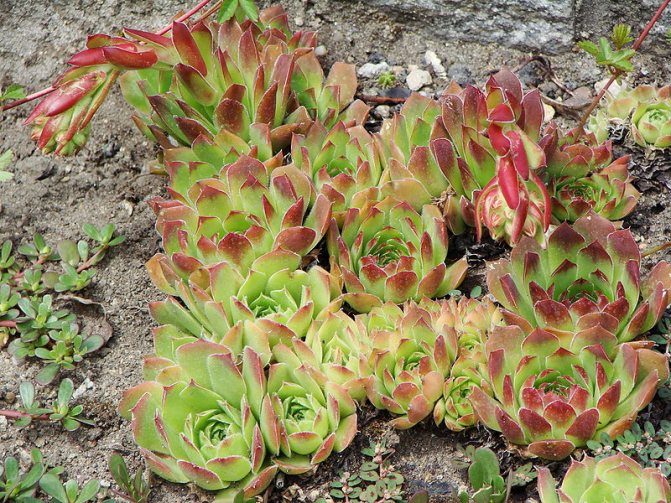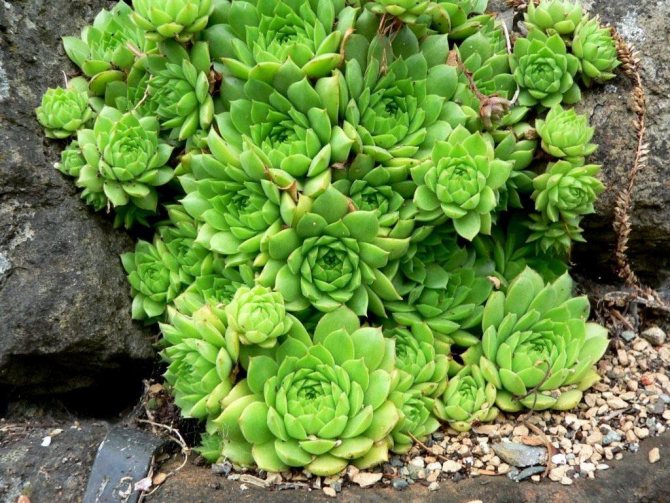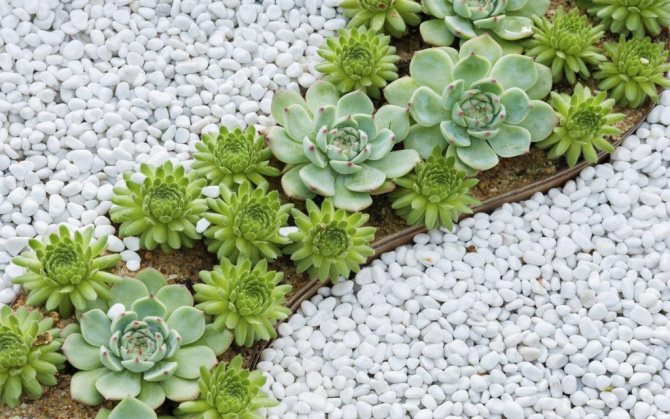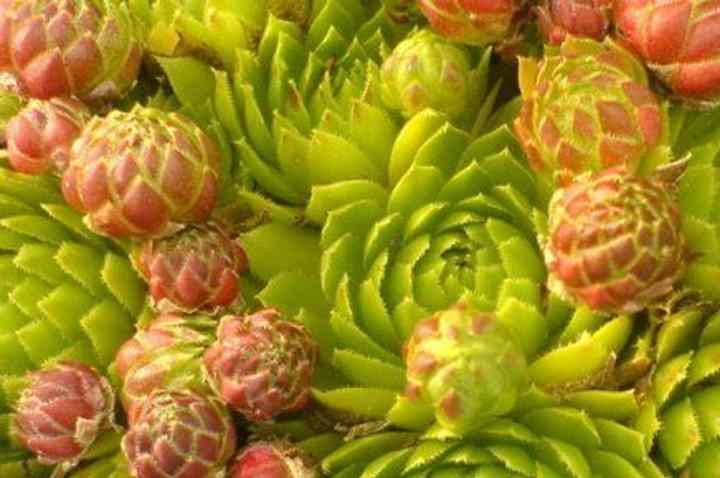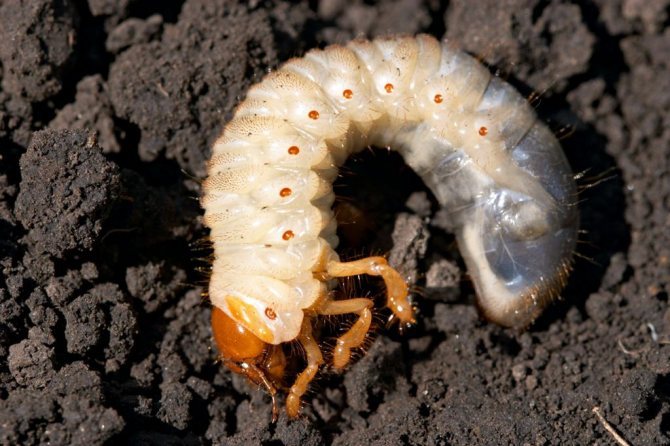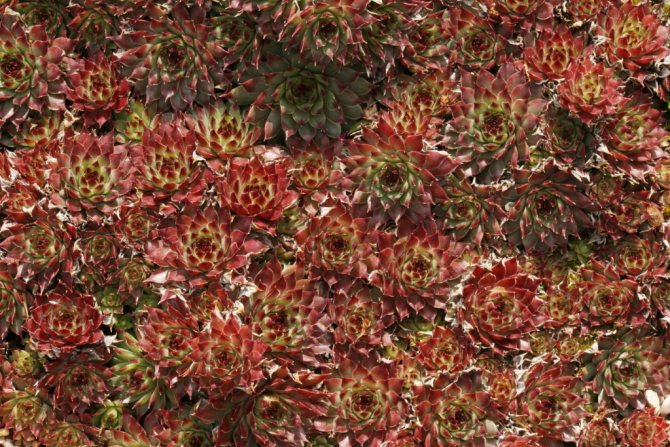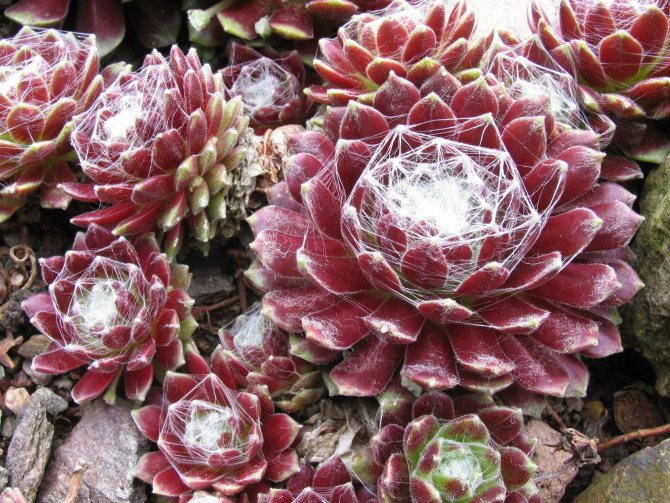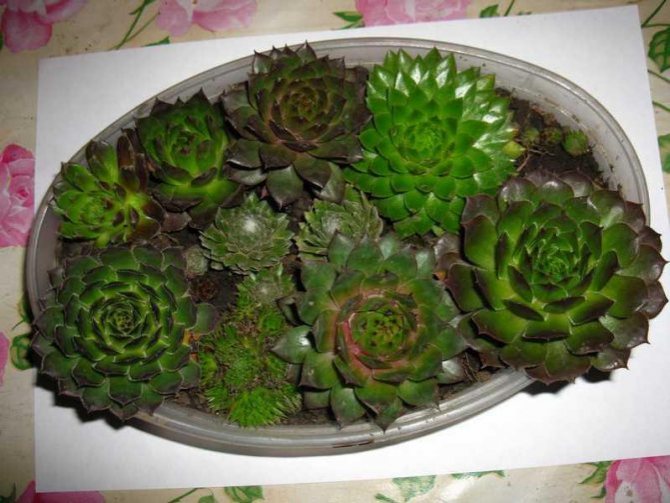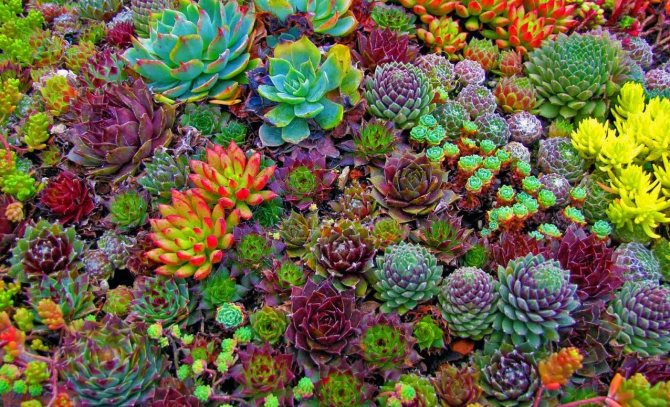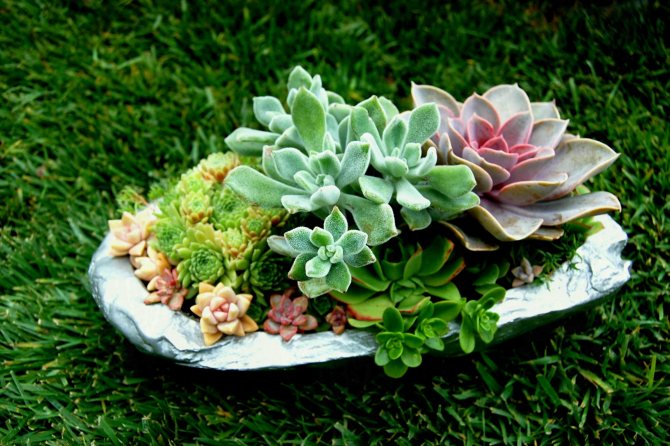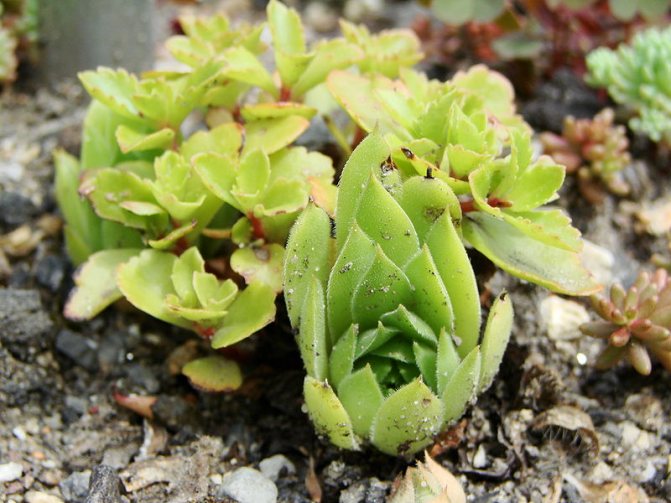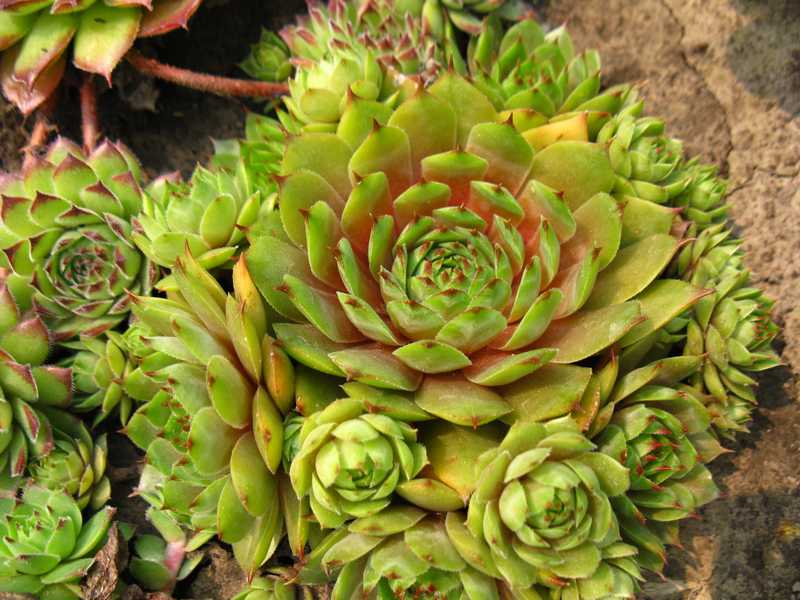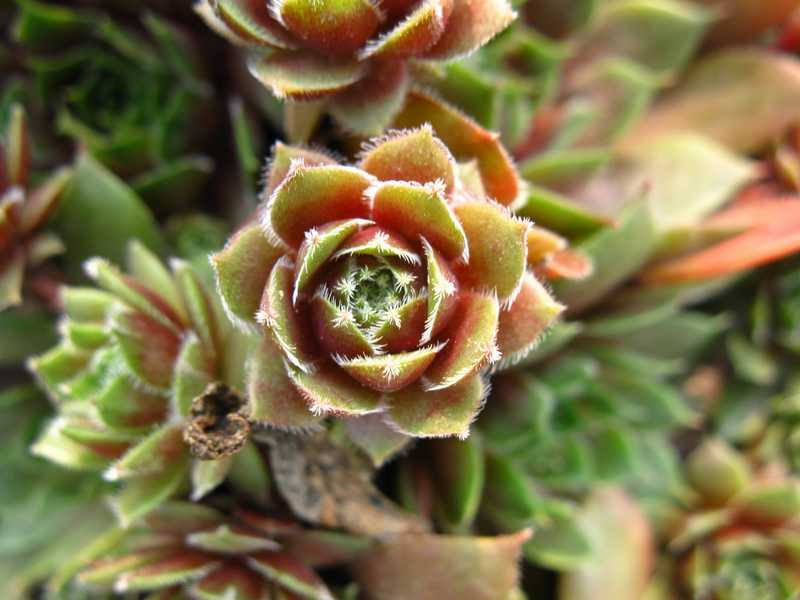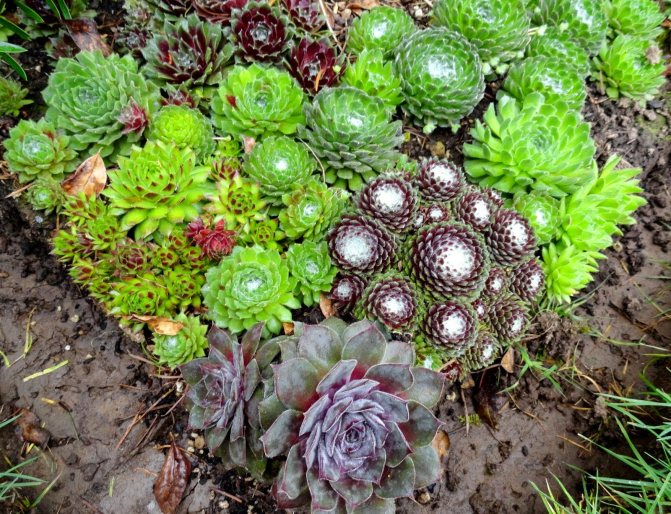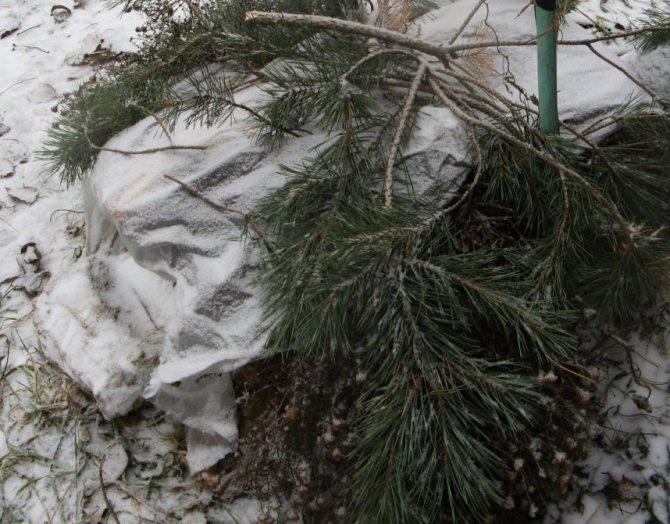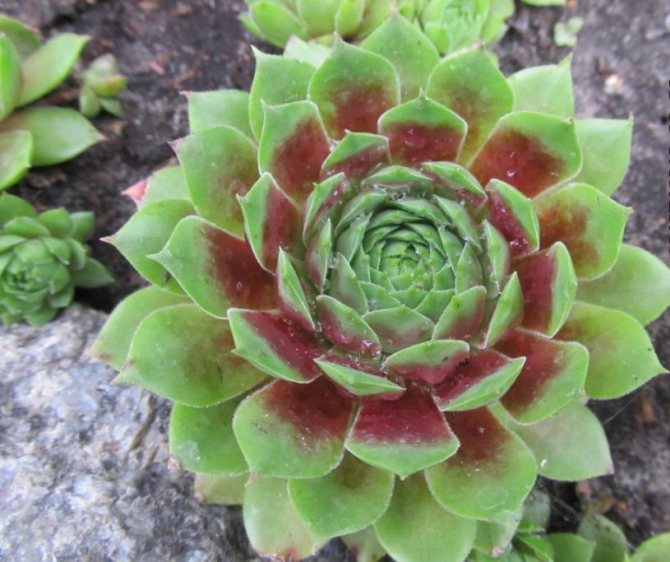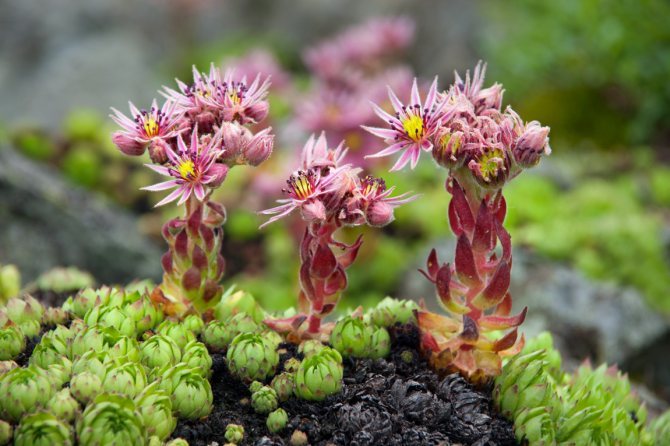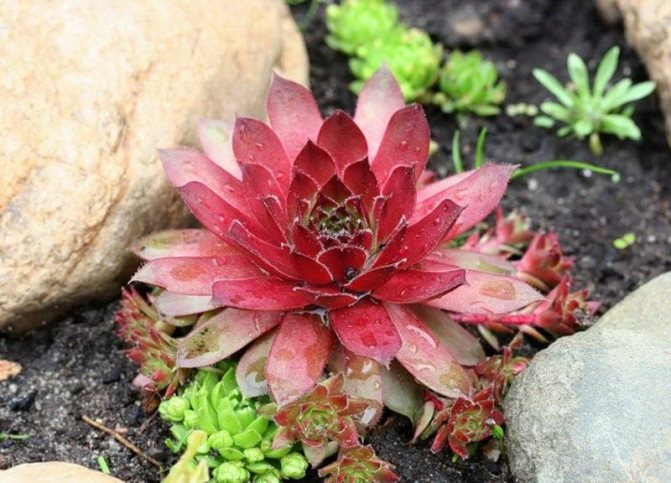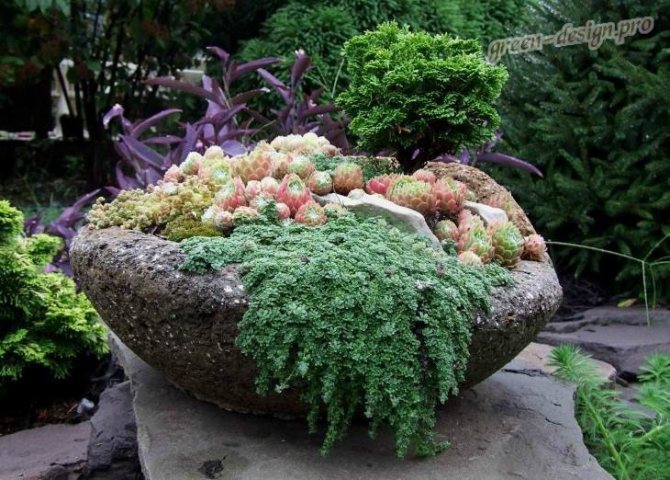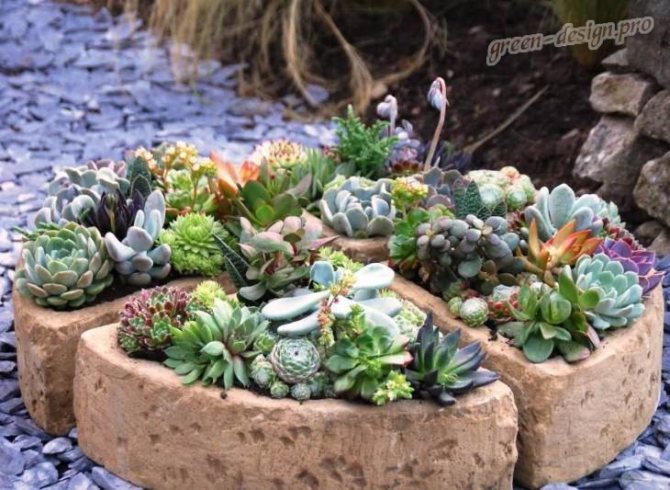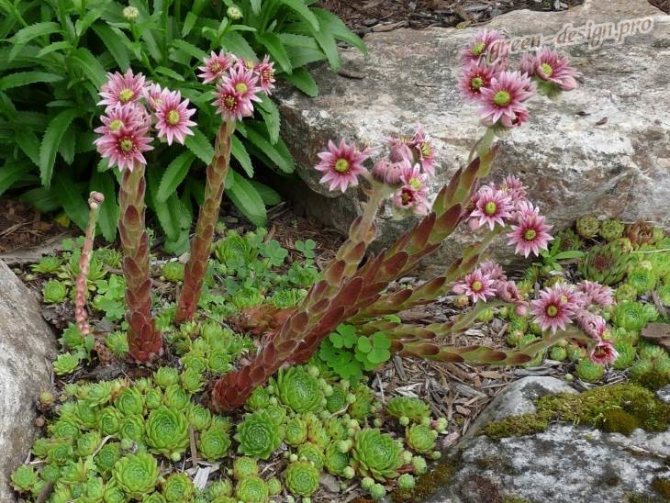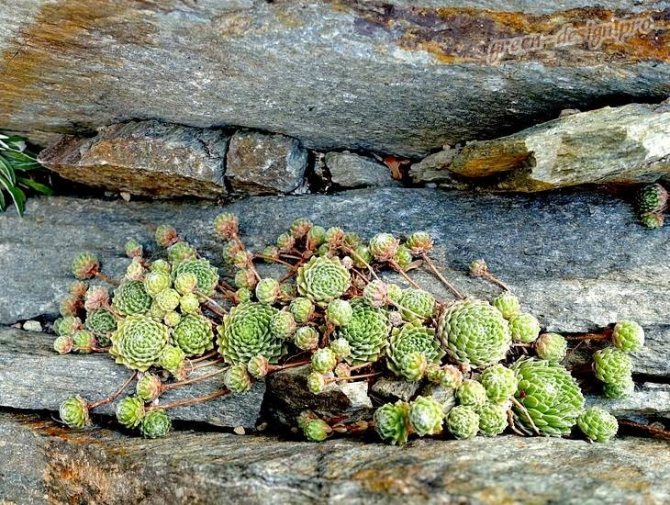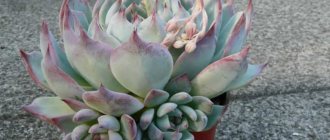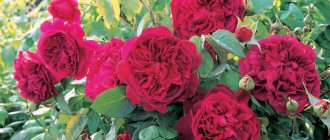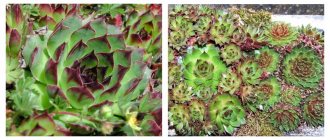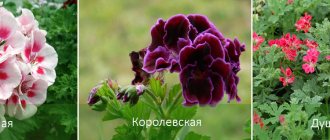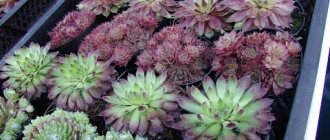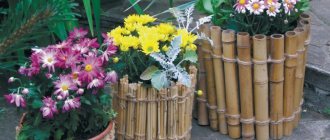What care does a flower need
Growing this plant is a simple matter. As they say, they stumbled into the ground - and forgot.
- Temperature. "Line", in which the young will not die - from -30 in winter to +30 (and even higher) in summer.
- Lighting. Do not plant the young in the shade - the plant will stretch upward, looking for the sun with its leaves, and will stretch out ugly. For the same reason, stone roses are not planted in the garden, where trees and bushes will shade them. An open flower bed is what this succulent needs.
- Top dressing. The plant does not need it, especially when planted in fresh soil. If the flower has been growing for about 4 years, you can feed it once with a mixture for succulents. If you regularly feed a stone rose, it, of course, will grow in breadth and upward, but it may lose some of its variegation, and it will be more afraid of frost.
- Watering. This plant is more afraid of excess moisture than drought. It is better to pour water not on the flower, but gently on the ground near it.
- Transfer. In general, it is not necessary for the flower if you sometimes (as described above) give fertilizers to the soil, or you feed the flowers growing nearby (the stone rose "steals" their food a little, it is enough for it).
- Pruning. In the fall, you can "clean up" the bushes from overgrown leaves a little, that's all.
- Wintering. As I said, the plant does not even need to be covered, it is not afraid of frost. If you throw a film on it, a greenhouse effect will begin under it, the humidity will increase, and this can kill the succulent. But you can throw twigs of spruce branches on a flower bed - they will not allow a large amount of snow to accumulate here, which means that in the spring there will be no excess moisture in the soil.
- Summer weeding. Always cut off any weeds that appear near your stone rose. Growing up, they will hide the succulent from the sun it needs, and they will regularly steal moisture from the soil.
You will hear more about growing a rabbit lip in the garden in this video:
Stone rose in the apartment
- The plant can be kept on the south window, and in the summer - on an open balcony (and you can move the pot there from early spring to late autumn).
- The flower pot does not need a deep one, drainage is necessarily poured at the bottom of it (the same expanded clay).
- The soil is suitable for the one sold for cacti.
- You can water the plant once every 2-4 weeks in winter and once every 7-10 days in summer, pouring water exclusively into the soil, without touching the leaves.
- In the spring, the flower can be fed with humus, spreading it on top of the soil.
- A flower transplant is not needed, but children will have to be removed from the pot often.
- Pests. If in flower beds a plant can suffer from May beetles and their larvae, then in an apartment - from a worm and aphids. These indoor insects are afraid of insecticides sold in flower shops.
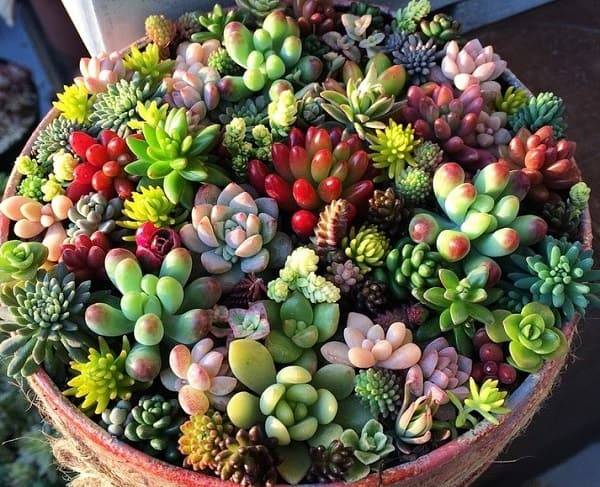
The subtleties of planting a stone rose in open soil
- Priming. "Free" grows young in mountainous areas, looking between stones. In these places, the soil consists mainly of clay and sand. Therefore, in the case of flower beds, you should not grow succulent in black soil. The flowerbed will have to be dug up by adding stones and crushed stone to the soil (they will perform the function of drainage), as well as sand. The soil for the flower should be as loose as possible.
- You can plant a plant on the site from late spring (March) to early autumn (September).Later, it is not necessary, the plant planted in October or November will not have time to take root before frost and may freeze in winter.
- The bushes grown in pots are transferred along with the soil. Grown in aqua soil are removed from their "disembodied" soil, slightly pressing the roots into the hole.
- The hole for the young is made shallow, since the roots of the plant are very small. Between the bushes, you need to leave at least 10 cm of freedom so that there is room for the children of the stone rose to grow.
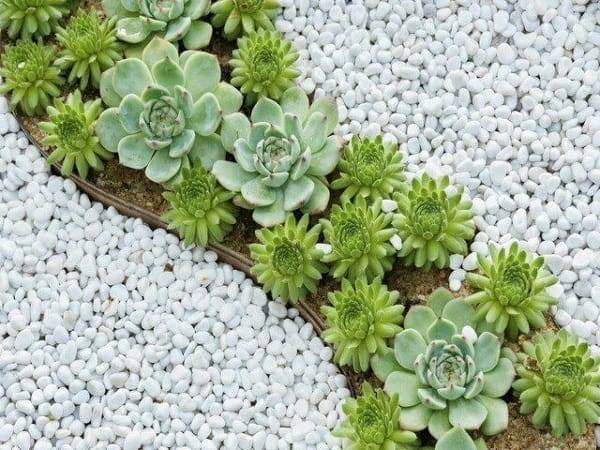

Reproduction was young
- Children. Their bushes grow in huge numbers. Children are taken out of the old soil (this is easy, because the roots lie superficially in the ground) and transferred to a new flower bed or pot.
- Seeds. They can be collected in your own flower bed. Seeds ripen in the last weeks of August. Sow them for the winter, they must overwinter in the ground. Seeds sprout in the spring and look very insecure. Do not touch them all summer, by September they will get stronger and grow, and next year you will have not only adult sockets, but also many children.
Did you know that the stone rose has long been the heroine of many popular superstitions? Which ones? They will tell you this in this video.
And note: the author talks about echeveria, but in fact describes the sempervivum (after all, it was this plant that the Europeans in the old days planted on the roofs of houses, thanks to which it even began to be called "roofing"):
Care
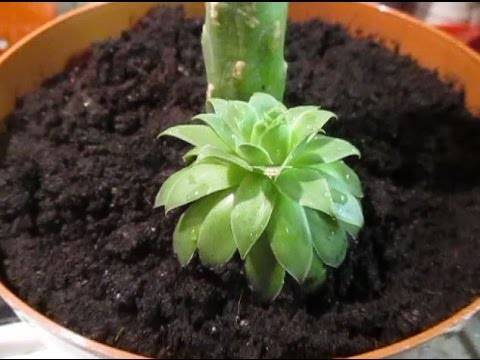

We will find out what kind of care a young person needs.
Watering
The plant needs moisture very rarely. Waterlogging should not be allowed categorically, since the roots of the young quickly rot. Therefore, it is recommended to water once or twice a month, not more often. In winter, the indoor flower is watered even less often: only once every 2-3 months.
Do not allow water to enter the outlet, as this can also lead to decay and mold.
Top dressing
The plant practically does not need additional nutrition. On the contrary, it is better to underfeed the young than overfeed. In conditions of excess nutrition, the plant is strongly stretched upward, losing its decorative effect.
However, top dressing is still needed from time to time, since the soil in the pot is gradually depleted. They begin to slowly feed the young ones no earlier than the plant turns four years old. We advise you to use complexes designed for succulents. Top dressing is applied once a month during the growing season, but always in half the dose.
Loosening
This procedure is very beneficial for the plant. Loosening increases the permeability of the soil, and also helps to get rid of weeds, pest larvae
It is only important to remember that the roots of the young are shallow, therefore it is necessary to loosen carefully
Pruning
The plant does not need regular pruning at all. It is only necessary to remove dried inflorescences and old leaves from below, which lose their decorative effect.
Transfer
In the same pot, a flower can grow safely for 4-7 years without needing a transplant. But there may be exceptions:
- varieties that grow rapidly;
- if root decay has begun.
In these cases, the young are transplanted quickly, and even urgently when the roots rot.
Care videos rejuvenated
Rejuvenated, stone rose, hare cabbage - all these are the names of one flower, which in recent years has become very popular among gardeners. And this is quite understandable: it grows in any conditions, does not require special care, reproduces independently, does not need a transplant. In addition, it retains its decorative effect throughout all seasons of the year, changing colors. The main thing to remember is to remove weeds in a timely manner and choose a sunny place for rejuvenating.
You can also share your secrets for rejuvenating care. If you have any questions - ask them in the comments below, we will be happy to answer them.
Popular types and varieties of stone rose plants and their photos
About fifty varieties of the stone rose are known.
Rejuvenated roofing is the most common variety that grows naturally in Eastern and Western Europe. The name was given due to the long-standing use of this species for roofing. The rosettes of the plant are flattened and spherical, ranging in size from four to fifteen centimeters. Large leaves have sharp red tops. It blooms in mid to late summer.
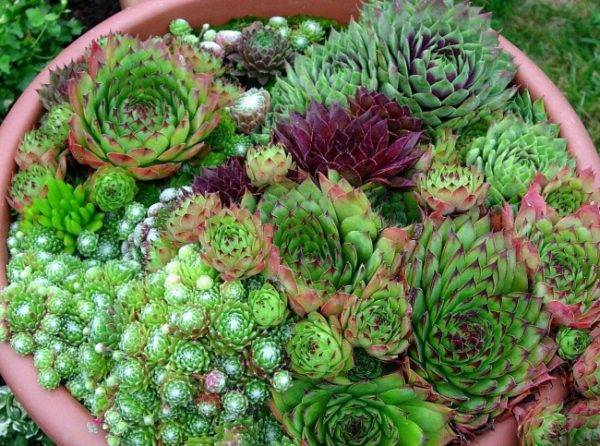

Photo. Rejuvenated roofing
Wulfen rejuvenated - in the wild, it is found in the Alps at an altitude of two thousand seven hundred meters. Grows on non-limestone rocks. The rosettes reach four to five centimeters in diameter. Shiny green leaves often have a reddish base and cilia at the edge. The shoots supporting the daughter rosettes are rigid and elongated. Peduncles reach twenty-five centimeters and bear bright yellow flowers with a burgundy spot at the base.
Photo. Wulfen rejuvenated
Lime rejuvenated is one of the most beautiful varieties. It has thinner leaves than other species. Eight-centimeter rosettes of bluish-green or gray-green colors with black or brown pointed ends. There are few flowers, they all have a pinkish color.
Photo. Lime rejuvenated
The offspring rejuvenated - a species found in the wild in the European part of the continent. Has rosettes in the form of a ball up to five centimeters in size. Yellowish and greenish flowers, collected in inflorescences, perfectly set off light green leaves. Bloom lasts from July to August.
Russian is rejuvenated - it grows in the Balkans, Asia Minor and the European part of Russia. The rosette diameter is six centimeters. Leaves on rosettes are elongated, pointed, on peduncles - covered with fluff on both sides. Peduncles reach a height of thirty-five centimeters, yellow flowers are collected in corymbose inflorescences. Flowering lasts from July to August.
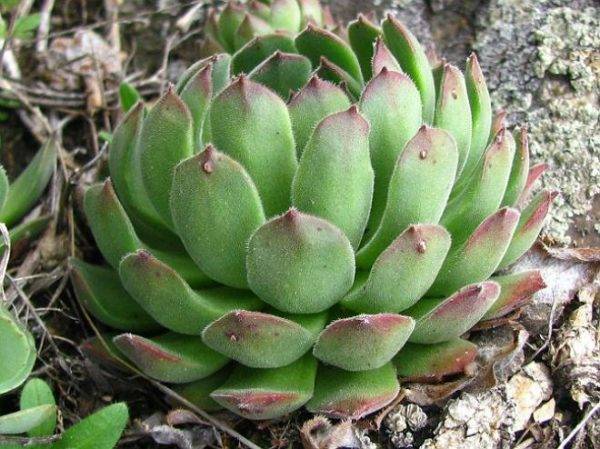

The cobweb was rejuvenated - a variety that received its name because of the cannon on rosettes, resembling a cobweb. The species is common in the Caucasus. The rosettes are very small, up to three centimeters in diameter. The flowers of the plant are reddish.
The young shoots are a plant with a small bright green rosette and a red border. Leaves are elongated with sharp edges and cilia, spherical rosettes are attached to the main flower with thin threads. Blooms in large yellow inflorescences.
Indoor varieties
Younger varieties differ in color, leaf shape, size of rosettes. More than 10 varieties are suitable for growing in an apartment, including dozens of hybrid varieties.
- The roofing was rejuvenated. Flattened leaf rosettes, low, small. The maximum diameter is about 7 cm. The color is green; cilia are visible along the edge of the oblong pointed leaves. When the light intensity changes, the leaves take on a reddish tint. The flowers are star-shaped, purple in color. They are collected in multiflorous corymbose inflorescences. Peduncles rise 40-60 cm above the ground. Flowering occurs in July-September.
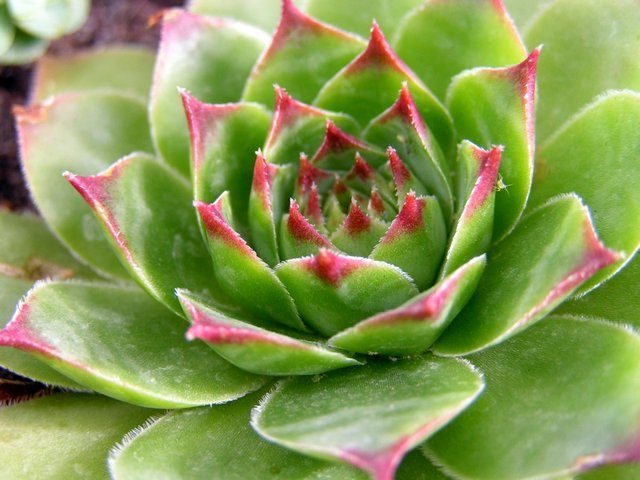

- The mountain was rejuvenated. Differs in very small rosettes. Their size does not exceed 2 cm. It grows rapidly and forms a dense carpet. Leaflets are lanceolate, pointed. The edges of the leaves are covered with long hairs, cilia. The surface is pubescent. Peduncles are short. The inflorescence is corymbose, collected from small purple-violet flowers.
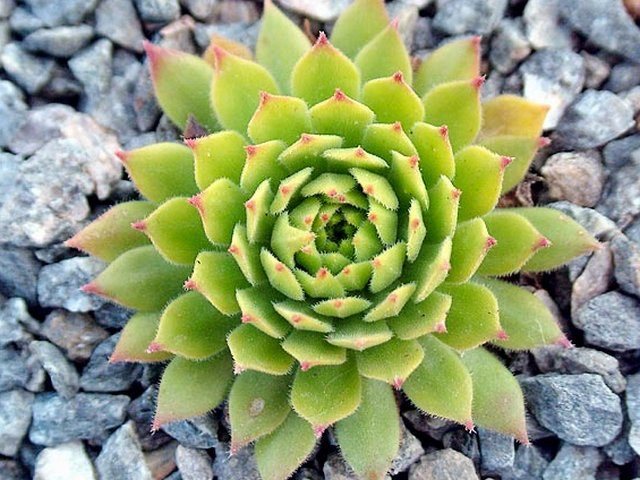

- The cobweb was rejuvenated. Leaf rosettes are small. A characteristic feature is the covering with a dense white cobweb. Inexperienced growers, a feature of the variety is often mistaken for a spider mite defeat. The flowers are pink, blooming in the middle of summer. Flowers exude a specific mushroom smell.
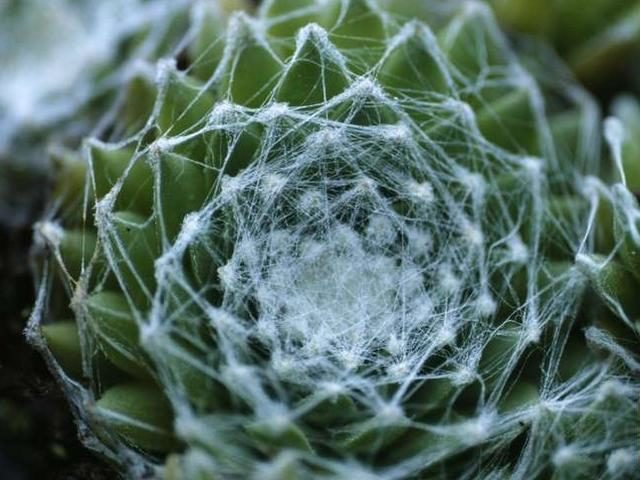

- The marble was rejuvenated.The leaf rosettes are flattened, relatively large. Young leaves with pubescence become bare as they grow. Color - green or red. Peduncles are of medium length.
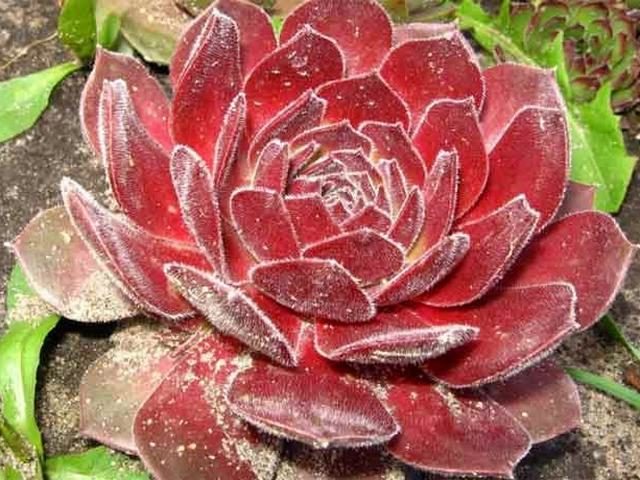

- The hybrid was rejuvenated. The combined name of numerous hybrid, artificially bred varieties. Among them, there are specimens with an unusual leaf shape or rosette shape. The colors are very different - green, gray, silver, burgundy. Two-tone varieties are popular.
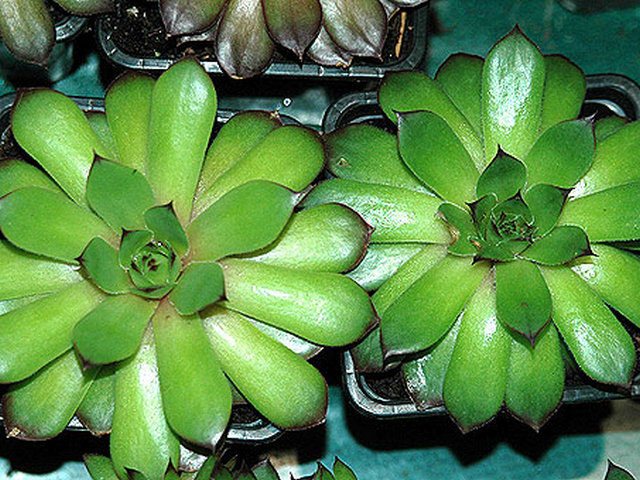

Advice! All varieties are surprisingly resistant to drought and other adverse factors. The only prerequisite for indoor growing is good lighting. Looks good rejuvenated, as an independent plant or as part of compositions of succulents.
Planting a stone rose outdoors
Most often, this beautiful flower is used in the design of garden plots.
Selecting and preparing a landing site
- The very first rule that you need to adhere to is that the tenacious loves the sun's rays, without them it will easily wither and die. Therefore, choose the most open areas, not darkened by shrubs and trees.
- For the same reason, the plant does not really combine with other flowers. The stone rose is very small, less than 10 cm (on average 8 cm), so even the smallest crops can easily cover it.
- Neat symmetrical echeverias look pretty in almost any container, so this moment may not worry gardeners.
- A succulent plant prefers rocky or sandy soil, in which it feels most comfortable. In principle, experts do not prohibit the use of different types (for example, loose and drained), since they are not particularly whimsical.
- As an additive, mix the earth with charcoal, expanded clay, or humus.
- For clay soils, it is advisable to use drainage that does not allow water to stagnate inside.
In such conditions, a stone rose will take root perfectly.
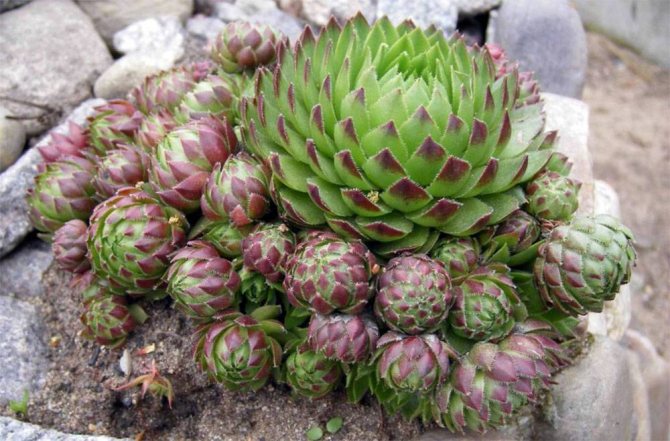

The tenacious loves the sun's rays, without them it will easily wither away and die
Technology and timing of planting a stone rose
- Usually, young shoots are planted in an open area during the summer months: June and July. August is already chilly, before the frost the hare cabbage simply does not have time to take root and the root system will die. But if you provide the plant with special conditions, then planting can be carried out all season.
- Clear the selected piece of land. Pull out all the weeds, even the smallest ones. In the future, they will not allow echveria to develop normally. An exception is the lawn.
- If you are afraid that the succulent plant may get an excess of water, equip the drainage: pour a little expanded clay on the bottom of the dug hole.
- The size of the fossa should not be too large. Focus on the volume of the roots.
- Gently pry the soil in the pot where the succulent is located with your hands or a spatula. Take out a single lump, sprinkle a little with your fingers, but not too much.
- Place the plant in the prepared hole, but not deep. Fill the roots with the remaining soil. Water the flower afterwards.
- If you are replanting more than one seedling, then observe a certain distance. It should be at least 10 cm, since hare cabbage grows quite strongly in breadth, some specimens reach 15 cm.
Agrotechnics
Important! A stone rose is a very unpretentious flower, so even a novice florist can take care of it. Succulent blooms well both at home and in the garden, in the country
Landing
In the open field, a stone rose can be planted in the most inaccessible places. She will feel good in the space between stones, wide flowerpots, any pots and containers. The unpretentiousness of the flower is explained by its high resistance to any conditions: drought and severe frosts.
To get a rich shade of leaves, it is better to choose a well-lit place for planting a stone rose. In the shade, she will be pale. When grown at home, the pot should be kept on the southern windowsill, provided with additional lighting.
Suitable soil for a flower is light, sandy. Drainage is required in the form of pebbles, expanded clay, fine gravel. Rejuvenated worse tolerates an acidic environment, so you should not add fertilizers. At home, a mixture of sand and peat mixed in a 3: 1 ratio, with the obligatory addition of drainage, is suitable.
Important! Planting of flower seedlings is carried out in the spring-summer season, in a previously loosened soil, cleared of weeds, diluted with sand and pebbles. Pits are made at a distance of 20 cm from each other
It is enough to leave 5 to 7 cm of space between dwarf flower varieties. Seedlings, together with a lump of earth, are placed at a shallow depth, sprinkled with soil, tamped and watered.
A rocky rose is planted mainly in seedlings, since many daughter outlets are formed around it. No wonder the French gave her another name - "hen with chickens." For indoor cultivation, the "daughters" of the stone rose are separated in September, placed in separate containers.
Note! When propagated by seeds, the growth of the flower slows down. Seeds are sown at the beginning of March.
A week later, seedlings appear, which are transplanted to a permanent place in the first days of July.
Sowing of seeds falls on the beginning of March. A week later, seedlings appear, which are transplanted to a permanent place in the first days of July.
Despite the unpretentiousness of the stone rose, it is still worth paying attention to the correct agricultural technology:
- Watering the flower should be rare, once a week in the summer, if necessary - in the winter. Waterlogging of the soil, ingress of moisture into the sockets - all this causes rotting of the roots and leaves of the rose. You need to water at the root.
- Weeding should be regular and neat so as not to damage young outlets.
- Feeding the flower is not needed. Only after 3-4 years can you use a mixture for feeding cacti, while it is recommended to add crushed charcoal. You can use humus.
- There is no need to spray or wipe the flower leaves, as they have their own protection in the form of a film. Drops of moisture under the sun can cause burns.
- After flowering, it is recommended to remove the dried inflorescence to allow the flower to regain strength for the new season.
Important! It is recommended not to transplant a stone rose, but to plant it. So that the numerous daughter outlets are not shallow, they are seated in another place.
A stone rose tolerates frost well under a snow shelter. To do this, it dries out in the fall, getting rid of excess moisture in the leaves. But recently planted, immature flowers should be covered with foliage or branches of coniferous trees.
Reproduction
The stone rose reproduces well without the participation of the gardener in a vegetative way. The mother plant forms many layers with daughter rosettes. Separation and disembarkation, if necessary, is carried out in the spring, less often in the summer. Small rosettes are first grown in beds or in containers, and then planted in a permanent place. Different types of juveniles, when grown together, sometimes self-pollinate. This allows you to get new unique hybrids.


The plant quickly forms daughter rosettes.
Rejuvenated can be grown from seeds. They are sown into the soil to a depth of 1 cm in February-March and kept indoors at a temperature of at least 20 ° C. The first shoots appear in 5-7 days. Small rosettes are kept in a well-lit place, but not in direct sunlight. They are planted in the garden at the end of June-July. Rejuvenated may not emerge due to care errors - excessive watering and high humidity.
Sometimes the plant is propagated by a petal. To do this, cut a leaf from an adult outlet with a sharp disinfected knife, dry the cut in the open air for 15 minutes. After they are planted in a slightly moistened sand mixture, they are covered with something transparent on top, creating a mini-greenhouse. Soon a young rosette will sprout next to the leaf.
What care does a flower need
Growing this plant is a simple matter. As they say, they stumbled into the ground - and forgot.
- Temperature. "Line", in which the young will not die - from -30 in winter to +30 (and even higher) in summer.
- Lighting. Do not plant the young in the shade - the plant will stretch upward, looking for the sun with its leaves, and will stretch out ugly. For the same reason, stone roses are not planted in the garden, where trees and bushes will shade them. An open flower bed is what this succulent needs.
- Top dressing. The plant does not need it, especially when planted in fresh soil. If the flower has been growing for about 4 years, you can feed it once with a mixture for succulents. If you regularly feed a stone rose, it, of course, will grow in breadth and upward, but it may lose some of its variegation, and it will be more afraid of frost.
- Watering. This plant is more afraid of excess moisture than drought. It is better to pour water not on the flower, but gently on the ground near it.
- Transfer. In general, it is not necessary for the flower if you sometimes (as described above) give fertilizers to the soil, or you feed the flowers growing nearby (the stone rose "steals" their food a little, it is enough for it).
- Pruning. In the fall, you can "clean up" the bushes from overgrown leaves a little, that's all.
- Wintering. As I said, the plant does not even need to be covered, it is not afraid of frost. If you throw a film on it, a greenhouse effect will begin under it, the humidity will increase, and this can kill the succulent. But you can throw twigs of spruce branches on a flower bed - they will not allow a large amount of snow to accumulate here, which means that in the spring there will be no excess moisture in the soil.
- Summer weeding. Always cut the weeds that have appeared near your stone rose. Growing up, they will hide the succulent from the sun it needs, and they will regularly steal moisture from the soil.
You will hear more about growing a rabbit lip in the garden in this video:
Stone rose in the apartment
- The plant can be kept on the south window, and in the summer - on an open balcony (and you can move the pot there from early spring to late autumn).
- The flower pot does not need a deep one, drainage is necessarily poured into its bottom (the same expanded clay).
- The soil is suitable for the one sold for cacti.
- You can water the plant once every 2-4 weeks in winter and once every 7-10 days in summer, pouring water exclusively into the soil, without touching the leaves.
- In the spring, the flower can be fed with humus, spreading it out on top of the soil.
- A flower transplant is not needed, but children will have to be removed from the pot often.
- Pests. If in flower beds a plant can suffer from May beetles and their larvae, then in an apartment - from a worm and aphids. These indoor insects are afraid of insecticides sold in flower shops.
The subtleties of planting a stone rose in open soil
- Priming. "Free" grows young in mountainous areas, looking between stones. In these places, the soil consists mainly of clay and sand. Therefore, in the case of flower beds, you should not grow succulent in black soil. The flowerbed will have to be dug up by adding stones and crushed stone to the soil (they will perform the function of drainage), as well as sand. The soil for the flower should be as loose as possible.
- You can plant a plant on the site from late spring (March) to early autumn (September). Later, it is not necessary, the plant planted in October or November will not have time to take root before frost and may freeze in winter.
- The bushes grown in pots are transferred along with the soil. Grown in aqua soil are removed from their "disembodied" soil, slightly pressing the roots into the hole.
- The hole for the young is made shallow, since the roots of the plant are very small. Between the bushes, you need to leave at least 10 cm of freedom so that there is room for the children of the stone rose to grow.
Reproduction was young
- Children. Their bushes grow in huge numbers. Children are taken out of the old soil (this is easy, because the roots lie superficially in the ground) and transferred to a new flower bed or pot.
- Seeds. They can be collected in your own flower bed.Seeds ripen in the last weeks of August. Sow them for the winter, they must overwinter in the ground. Seeds sprout in the spring and look very insecure. Do not touch them all summer, by September they will get stronger and grow, and next year you will have not only adult sockets, but also many children.
Did you know that the stone rose has long been the heroine of many popular superstitions? Which ones? They will tell you this in this video.
And note: the author talks about echeveria, but in fact describes the sempervivum (after all, it was this plant that the Europeans in the old days planted on the roofs of houses, thanks to which it even began to be called "roofing"):
The main signs of a stone rose flower
The name of the plant is translated from Latin as "eternally alive". Another name sounds like "hare cabbage", as the flower looks like a head of cabbage. According to legend, he is able to protect a house from lightning strikes, so some especially superstitious people plant him on the roof. Hence another name - "roofing youth".
The plant retains its attractive appearance for almost the entire season. Dense deciduous rosettes do not lose their elasticity and freshness not in the apartment, not on the site. Soil quality, maintenance and watering gaps, and temperature fluctuations will not destroy the outlet. On good soil of humus and compost, the flower will look great. The diameter of a healthy plant can reach 15 cm. Some individuals can be of an unusual color (ruby, purple, brown), which makes the interior or landscape design even more picturesque.
What if the plant does not take root?
Rejuvenated is a completely undemanding flower and takes root very successfully at home. Problems after landing are rare and are most often associated with a gross violation of containment conditions.
- If the stone rose does not take root, you need to check the moisture level of the soil. Extremely rare watering does not allow the roots of a young rosette to develop. In order for the daughter shoot to take root, it is necessary to regularly moisten the soil.
- In the case when the plant withers and traces of rot appear on it, it is necessary to urgently release the young from the ground, clean the unhealthy parts and root it again in fresh soil. Reduce watering, avoiding excessive waterlogging of the substrate.
Rejuvenated - easy to care for and very original plant, with the maintenance and reproduction of which even a novice florist can cope. A rich variety of species and adherence to elementary growing rules allow you to collect on the windowsill a spectacular collection of stone rose specimens.
If you find an error, please select a piece of text and press Ctrl + Enter.
Description of the stone rose
The name of the flower is due to the similarity of the fleshy leaves with rose petals. But, in comparison with an ordinary rose, this flower is unusually vigorous, strong as a stone. The plant survives on rocks, stony soils, sandstones, forest outskirts. The Latin name comes from 2 words: "semper" - "always" and "vivius" - "alive". The popular name of the flower is "tenacious". In nature, the plant grows in the Caucasus, Northern and Eastern Europe and Asia.
During the Middle Ages, Europeans had a superstition that the rosettes of the stone rose bestow the patronage of the deity Thor. According to the sign, a flower planted on the roof protected the home from lightning and thunder strikes. For this, he even received the name "thunder grass". At the same time, the succulent served to strengthen the roof, having the property of germinating wherever there was no tile.
Rubbing the cheeks with the leaves of the flower helped the girls regain their blush and look younger, so one of the common names for the flower was rejuvenating. For its compactness and similarity to the cabbage head, the plant is called "hare cabbage". Infusions and decoctions of the flower have a healing effect in the healing of wounds, diseases of the heart, lungs, and stomach.
The stone rose fits perfectly into the landscape design:
- adjoins well with low flowers;
- decorates garden paths, borders and flower beds;
- creates a lively, colorful blanket on the site;
- becomes part of the design garden composition.
On a note! The unpretentious succulent is rightfully considered an indispensable member of modern landscape ensembles. The flower is able to maintain a beautiful appearance throughout the year, striking in the richness of colors and shades.
Flowering period
The rejuvenated blooms with variegated, bright flowers with pointed petals. The size and color depends on the type of plant and can be red, yellow, pink, white, purple. However, the plant is valued for the decorativeness of the rosettes, therefore it is used in landscape design regardless of flowering.
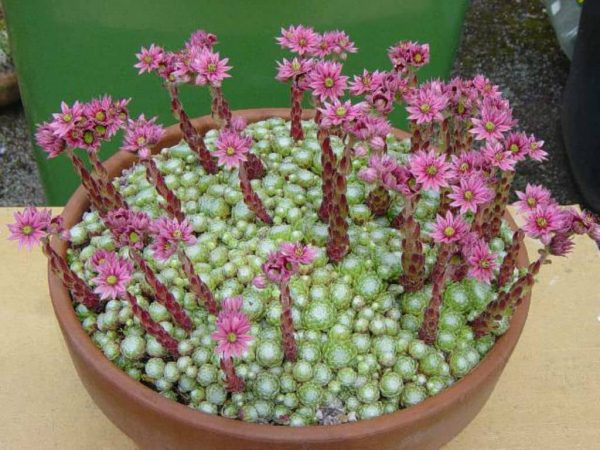

Rejuvenated blooms.
Plants that have reached 2-3 years of age bloom. Each rosette blooms once. Then seeds are formed, and the rosette gradually dries out and dies off. The flowering period lasts throughout the summer. Sometimes rejuvenation may not bloom for many years - plants need stress (temperature drop or change in other conditions) for the set of buds. The dense and compact planting of the rosettes ensures flowering even in young specimens.
Diseases and pests
The strong immunity of the stone rose helps it to cope with most diseases and pests. But some insects can still harm the flower.
May beetle larvae eat long passages in the plant. You can save the young by replanting to another place and treating the soil with chemicals.
Important! Improper care causes the parts of the stone rose to rot. Frequent watering, stagnant water and wetting of the outlet are contraindicated for her.
The decayed part of the flower must be cut off, disinfected the plant, transplanted to another place. Rotten-rooted roses should be destroyed to avoid contamination of healthy flowers.
Weeds can become the flower's worst enemies. They steal nutrients from him, retain moisture. Tall weeds obscure the young, causing it to die slowly. Weeding should be regular.
Growing a stone rose is practically no hassle for its owner. At the same time, the flower decorates well any garden, office or room.
Somehow, a mother-in-law living in another city called and boasted: they said, she dropped the young for me. This was the first time I heard this name, so I asked "What-what?" - "Well, a hare lip, a tenaciousness, a flower for the lazy!" - no less vaguely explained her husband's mother.
I had already decided that we were talking about some rare steppe plant and even felt a little sad when I imagined how this "weeds" would look next to my favorite succulents. But it turned out that this is nothing more than the popular name of the sempervivum, the stone rose!
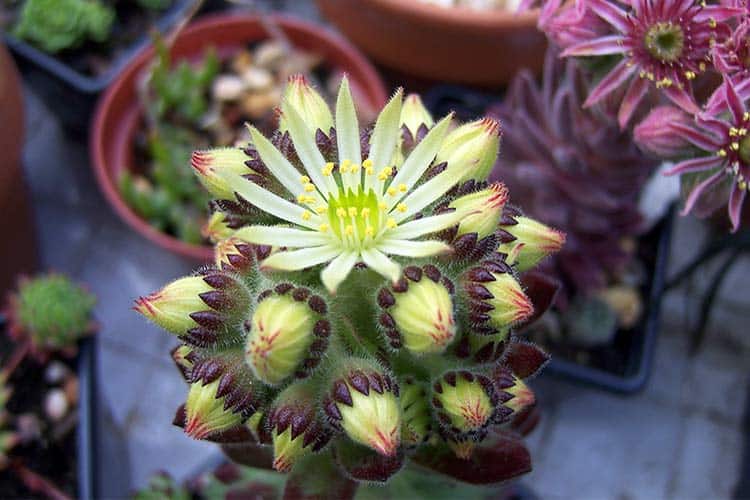

Growing problems
Stone flowers are rarely attacked by diseases and pests. Weeds, which take nutrients from the soil, pose a great danger to young plants. Growing up, they obscure the rejuvenation, which prevents normal development.
In order for the outlet to resist weeds, it is necessary to plant a plant that has already grown stronger, and regularly pull out the weeds. The rejuvenated grows quickly, so soon a carpet of dense rosettes will not leave the weeds a single chance.
Pests
The plant is usually attacked by the larvae of May beetles and birds. The former eat up the root system completely, the latter peck out the rosettes to the stem. Instead of outlets damaged by larvae, it is necessary to plant new ones, having previously checked the soil for the absence of pests. It is more difficult to prevent birds, it remains only to re-root the damaged sockets. However, due to intensive growth, the loss of the entire species is unlikely to threaten the site.
Diseases
Of the diseases, the stone rose is affected by rot. Occurs with excess moisture - frequent watering.The leaves become lethargic and watery, but the plant is not contagious - it just needs to be removed from the area.
Sometimes, when grown in too poor soil and lack of moisture, the rosettes begin to curl. In this case, in order to return them to decorativeness, it is enough to provide normal conditions of detention.
Application rejuvenated in the garden
The plant is rejuvenated or a stone rose is suitable both for container planting and for growing in the open field. In the first case, you can get a mini-garden for a forgetful housewife, because watering is needed no more than 1-2 times a month. The main conditions are drainage and good lighting. If the flower is planted outdoors, then it is better to find a place devoid of even partial shade. Landing in lowlands where precipitation accumulates is highly discouraged, because there is a high probability of decay.
The plant thrives in well-drained soil
Reproduction was young
Reproduction of the "stone rose" is possible in two ways: vegetatively and by shoots. Consider how to grow young from seeds:
- take a container with a dredge for cacti;
- plant seeds without powder, slightly pressing into the ground;
- cover in a warm room for 2 months with watering through a spray bottle;
- dive at a distance of 5 cm from each other in pots or into a pre-moistened hole, 1/3 filled with drainage.
The shoots of the plant are clearly visible in the photo.
Propagation by shoots is even easier. First, you can pick up a site in which they themselves will creep around the mother's outlet. Secondly, a young plant can be transplanted with an earthen clod without injuring the root system. The main thing is to cut the antennae correctly so that it stays with the daughter process.
How to care for a stone rose plant
Stone rose maintenance is minimal. It is only required to regularly remove faded buds and do a cosmetic transplant every 3-4 years so that the plant does not shrink due to lack of territory for growth. Watering should be done carefully, without getting into the outlet itself. You do not need to cover the plant for the winter - it can withstand up to 30 degrees of frost. Mulching with gravel, expanded clay, crushed stone will help level the occurrence of weeds on the site.
Plot decoration
Designers recommend the plant for rockeries. Rock garden, slides, disguising unsightly soil types with pebbles are great options for threshing. But even in standard large pots for outdoor use, it looks impressive. The main thing is to choose the perfect neighborhood so that other plants do not shade the stone rose. In flower beds, it is placed in the foreground and slightly away from other types of flowers.
From the thresher, original mono-compositions are obtained using multi-colored varieties.
But the most unexpected and very beautiful stone rose looks with vertical gardening. Small areas may not always accommodate all the plants the owner wants to see. But the placement of bright rosettes threshed in pots or in the wall will allow you to enjoy your own piece of nature without violating the overall design idea of the territory. Fans of the vintage style can use almost any unnecessary container for planting a thresher: a trough, an old shoe. It is also used for border decoration.
The unpretentiousness and originality of the stone rose make it in demand in the landscape design of any site.
The healing properties of echeveria (echeveria)
Rejuvenated - means that medicinal properties help women rejuvenate... Previously, some of its types were used in the treatment of epilepsy, fever, etc. They removed facial pigmentation and freckles.
It is useful to keep the young at home: the flower will help cure respiratory diseases and reduce fever.
For various skin diseases, it is recommended to drink an infusion of rejuvenation or apply externally.
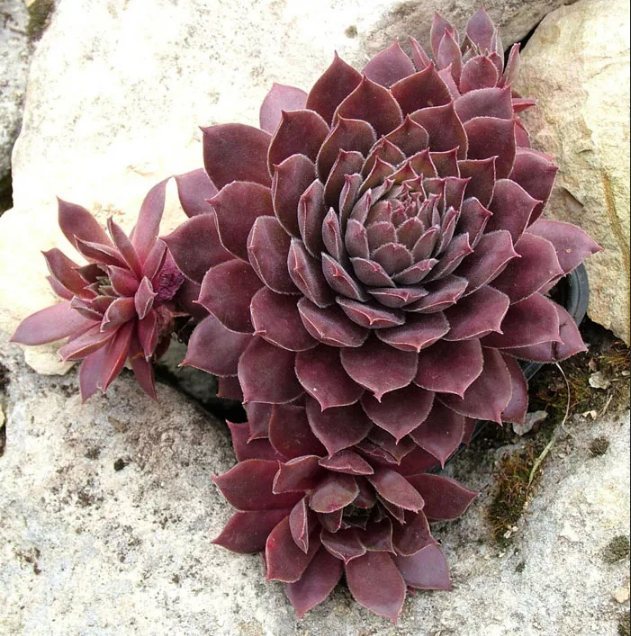

It helps well against eye diseases, mental disorders.For a long time, the Indians drank the fresh juice of Echeveria as a refreshing healthy drink.
Description
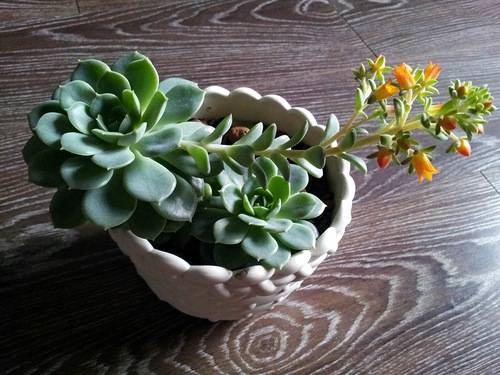

The plant is called a stone rose only in Russia and the CIS countries, in other regions and in the scientific world, the flower is called youthful. The people can also find the following names: "hare cabbage", "tenacious". Translated from the Latin alphabet, the word "young" means "eternally alive."
The plant belongs to the jumbo family and is, in fact, a succulent. Its appearance is extremely unusual: many juicy fleshy leaves, forming beautiful patterns, dense and durable, similar to shell or scales. Photo on the site.
The leaves are arranged evenly and symmetrically around the main stem, which is usually not visible. Sometimes foliage forms rosettes of larger or smaller diameters. The stone rose blooms: its flowers are in the shape of stars, and in due time they are transformed into egg-shaped fruits. In nature, you can find rejuvenated in the mountains of the Caucasus, in the south of the United States.
Transplant features
Regular transplanting is a mandatory procedure when growing a stone rose at home. This is done in the warm season, so that the plant has time to adapt in a new container before the dormant period. Before transplanting, do not water the soil, but carefully remove a dry earthen lump from the pot along with the roots. By tapping lightly, the old soil is removed. Dry and dead roots are also cut off. After that, all sections are treated with a fungicidal preparation.
A stone rose is moved into a new container and the roots are properly straightened, sprinkled with new soil.
After transplantation, Echeveria cannot be watered, it is kept in dry ground for about a week and only then regular moistening is resumed so as not to provoke decay of the roots.
Views
About 500 species of stone rose are known, but in Russia, due to the climate, only about 50 of them are cultivated. Consider the most attractive varieties for home cultivation.
Roofing
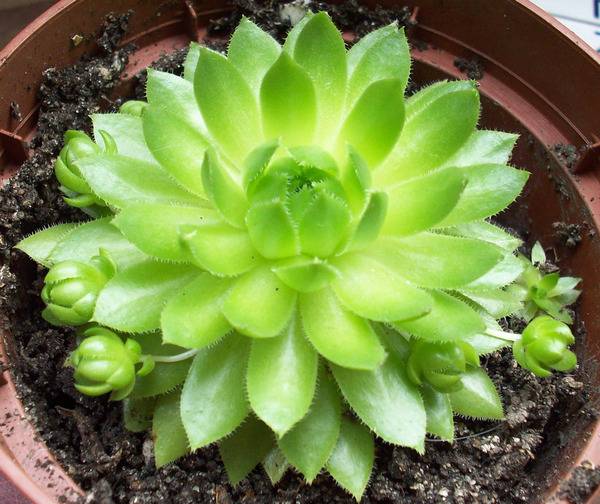

The most popular species in Europe was rejuvenated. The flower is formed from spherical rosettes, slightly flattened at the top. The diameter of one rosette can vary from 7 to 15 cm. The foliage is fleshy, dense, the tips are pointed. The color of the leaves is interesting: reddish-brownish with a bronze tint. Flowering is decorative: during this period, the stone rose is strewn with pink flowers.
Caucasian
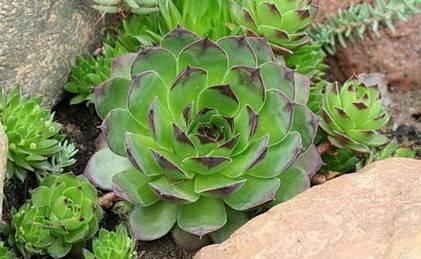

It is also an interesting variety, found naturally in the mountains in the south of Russia. The leaves have a greenish tint, are decorated with hard nap along the edges. The flowers are red-violet. Feels great in rocky soil; when growing at home, she needs abundant calcium supplements.
Marble
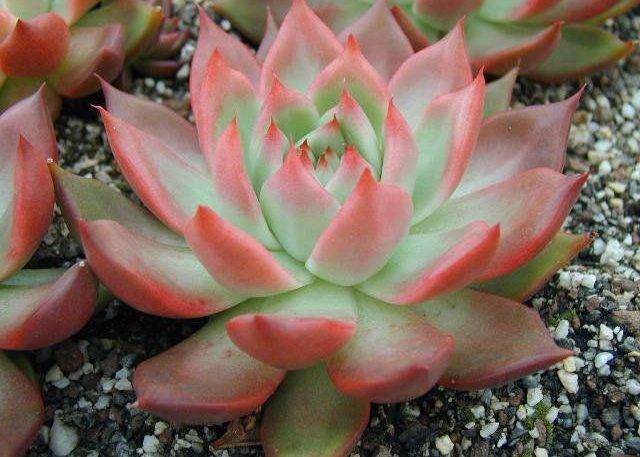

The succulent plant has a decorative coloration with red and green streaks. By winter, sometimes the foliage turns red completely. Flowers with pale red petals have a decorative white rim around the edges.
Russian
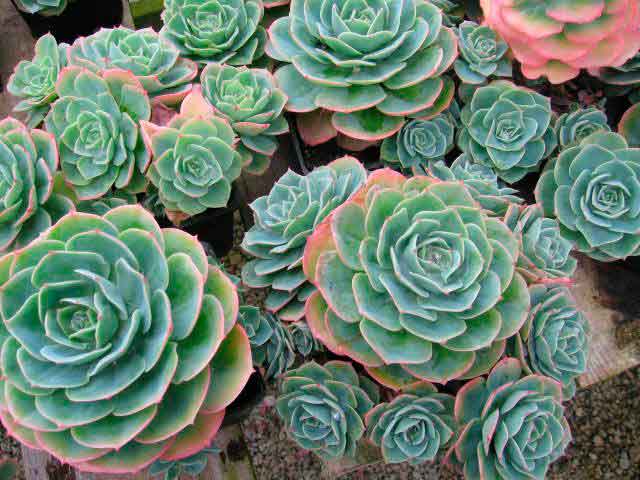

Grows in forest and steppe regions of the middle zone and in the south. Has a well-developed fleshy rosette, consisting of dense, juicy green leaves. The flowers are yellow.
Description and distinctive features of the plant
Stone rose, rejuvenated or hare lip belongs to the Tolstyankov family and is considered one of the most unpretentious succulents. Due to the high ability to survive and develop even in the most difficult conditions, the young are also called tenacious. Both at home and in the open field, succulents show high rates of survival, and for the office it is difficult to find a more suitable plant that fits perfectly into a minimalistic design.
In total, about 500 species of stone rose are known, but in our regions, about 50 species are most widespread. Before purchasing a succulent, it is worth studying the detailed description and, based on this, make your choice. The main difference between stone rose varieties is the color palette.
Graceful
This succulent is endowed with a thick stem, it can creep along the soil and put out roots, on which light leaves are present.They are collected in a rosette 15 cm in diameter, at the top of the stone rose ends with a thorn. At home, it feels comfortable and looks really elegant, which justifies its name.
Echeveria Derenberg
A succulent plant has a long flowering period. The creeping stems are decorated with rosettes resembling a slightly open spruce cone in shape. The leaves are covered with a bluish waxy bloom, and a red border goes along the edge.
Bristly
Rosettes of bristly echeveria look like dense balls, painted in dark green and with dense pubescence. The flowers of the succulent are also surrounded by a cloud of the same cannon.
Crimson
A distinctive feature of crimson echeveria is a strong stem, which is crowned with a rosette with pubescent leaves. The flowers of the stone rose are painted red with a yellow border around the edge.
Humpback-flowered
The plant has a straight stem and unusual large concave leaves. A bright spike-shaped flower crowns all this splendor.
Sizaya
Ideal for growing in pots on a windowsill. The original foliage has a grayish blue tint.
Signs and superstitions associated with a stone rose
Echevaria has a rather controversial fame: some believe that the plant does not carry negative emotions, others are afraid to start hare cabbage at home or in the garden, as they believe in its negative energy. I must say that the second superstition appeared due to the fact that the stone rose is often planted in cemeteries. Such a choice is not surprising, the plant is practically unpretentious, it feels great on stones, it does not need to be watered often, it survives drought calmly and at the same time looks great. But, like any other living creature, the tenacious is capable of absorbing bad emotions (but also positive ones).
And so the plant has a good reputation since the days of Antiquity. In ancient Rome, the flower was called a talisman, it was believed that it was able to drive away evil from its owner. This superstition was not forgotten in the later era of the Early Middle Ages: Charlemagne ordered to plant it on the roofs of houses to "scare off" lightning. So the stone rose became the first "lightning rod".
Wintering was young
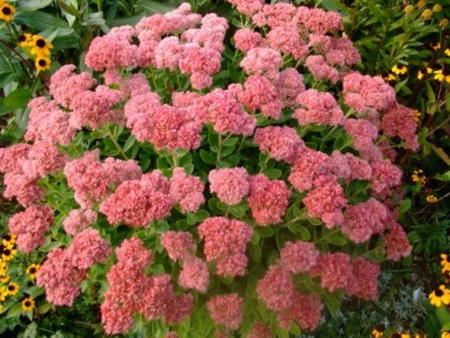

Given the phenomenal endurance of the plant, it is not at all necessary to cover it for the winter. Moreover, this can cause the death of the young - in the spring, during the thaw period, the flower vomits out under a dense shelter.
If in the spring you find that some of the stems of the plant are dry, remove them and replace them with young rosettes. Even if you don’t do this, the youth will grow itself into a lush carpet.
If the young are for the first time to overwinter in the garden under the snow, you can slightly cover the plants with spruce branches, you also need to protect expensive varieties of flowers from the cold. Gardeners recommend protecting the most valuable varieties of juveniles with a plastic bottle. In the spring, some plant varieties change their color and become a little brighter, these are natural changes and are not dangerous for the young.


